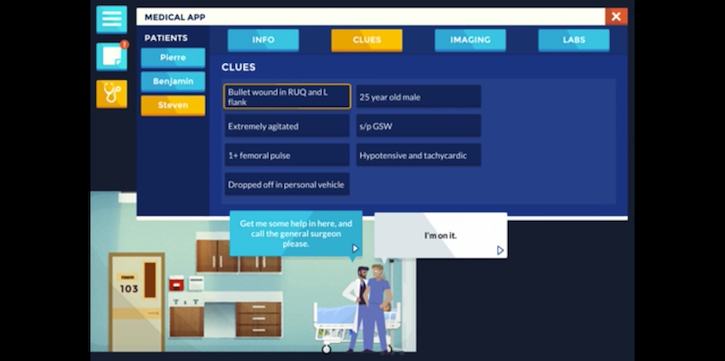Gamified Triage Training: It Doesn't Have to Be Fun to Be Effective
“Though enjoyment is one pathway to engagement, it is not the only one,” a new study concluded.

(Screen shot from Night Shift, courtesy Schell Games)
Less than half of doctors who played Night Shift found it enjoyable, according to a new study published in the British Medical Journal. Of course, the situations that the video game simulates aren’t often enjoyable, either.
Developed by Pittsburgh-based Schell Games and tested by the University of Pittsburgh School of Medicine, Night Shift is an adventure game designed to teach non-trauma physicians about how to triage patients with severe traumatic injuries. Such situations require quick action, and most physicians have inadequate experience in them.
“Each year, 30,000 preventable deaths occur after injury, in part because patients with severe injuries who initially present to non-trauma centers are not promptly transferred to a hospital that can provide appropriate care," lead author Deepika Mohan, MD, MPH, said in a statement.
An assistant professor in Pitt's departments of Critical Care Medicine and Surgery, she worked with Schell Games to develop Night Shift. Doctors were randomized to either play the game or receive traditional didactic education, both using an iPad. In total, 368 physicians took part, and a random sample of 200 participated in a 6-month follow-up assessment. Results were promising, physician enjoyment notwithstanding.
The game emphasized heuristic decision-making, presenting players with a scenario—like a patient with a gunshot wound—and a series of clues about their condition. The scenarios were meant to add narrative engagement, and doctors were required to make quick decisions on how to treat the simulated patients. Physicians who instead received didactic education were tested on the same scenarios.
Those who played the game under-triaged hypothetical patients 53% of the time, while those who received text education did so 64% of the time. At the 6-month follow-up, retention fell unequally and the gap widened: the Night Shift cohort under-triaged 57% at the time, but the didactic education group did so 74% of the time.
Doctors who received traditional educational materials, however, were more likely to enjoy their training than doctors who played the game. Usability issues may have detracted from the playing experience, the study authors noted, and doctors of different ages may respond differently to the use of tablet-based video games for training. “Though enjoyment is one pathway to engagement, it is not the only one,” the team concluded.
"An hour of playing the video game recalibrated physicians' brains to such a degree that, six months later, they were still out-performing their peers in recognizing severe trauma," Mohan said. “Recalibrating heuristics won't completely solve the under-triage problem…But it's heartening to know we're on track to develop a game that shows promise at improving on current educational training."
Related Coverage:
Gamified Technology Brings New Life to Disease ManagementIs Gamification the Key To Wearables?Can Gamification Teach Young People How Health Insurance Works?
Podcast: Match Made in Hospitals — Patient-Matching Technology Can Improve Healthcare
September 21st 2021Clay Ritchey, CEO of Verato, highlights the administrative and financial benefits that patient-matching technology can provide hospitals and health systems, as well as how it can improve the patient experience.
Podcast: Using Digital Solutions to Address Technology Shortfalls with Citius Tech Senior VPs
July 29th 2021In an interview recorded earlier this year, Chief Healthcare Executive Associate Editorial Director Mary Caffrey spoke with 2 leaders of Citius Tech about meeting healthcare challenges with digital solutions.